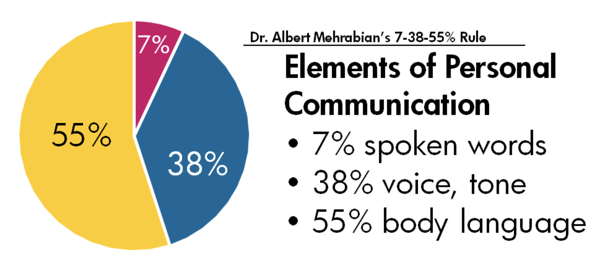To Telephone or Not to Telephone?
After reading Dr Andrew Baird's fantastic recent article in Pulse+IT, I thought there was no better time to weigh in on this hot topic.
There is a wealth of research that indicates face-to-face communication provides a number of benefits compared to communication that is only verbal. No doubt communication in all forms has been studied since humans could first talk and I am sure many a King’s messenger wished they could’ve just sent an email to a rival King rather than deliver it face-to-face and most likely suffer the consequences.
But perhaps one of the most significant research theories comes from Prof. Albert Mehrabian, whose research during the 1960’s lead to the 7-38-55% communication rule:
 Source: University of California, Los Angeles
Source: University of California, Los Angeles
When it comes to treating your patient face-to-face, you’ll get the whole gamut; emotion, eye contact/lack of eye contact, fidgeting, facial expressions, blushing and maybe even that light perspiration. If you are unable to have a face to face consult with your patient, say, due to COVID-19 isolation reasons, how much of the physical aspects will you miss? And if you’re on a video call, now how much will you miss?
I’m not suggesting that the phone doesn’t have it’s place. Maybe it is appropriate for a long-term patient who is travelling and requires a new script? Or, the provision of results which require no further follow-up once delivered? Regardless of those patient cohorts, it is still possible to miss some very important cues.
Clinical use and diagnosis
During the 2009 Swine-flu epidemic, the UK recorded a number of misdiagnoses when consultations were offered over the telephone. The misdiagnoses were based on the fact that the patient could only report their symptoms verbally over the phone, and the clinician was unable to inspect their throat which could have clarified the situation.
While there are a number of factors to take into account with each consultation, video calls are clearly able to reduce the risk of misdiagnosis as video calls provide for greater depth of information and often allow for resource sharing (images, documents, videos) during the call. This can improve decision making for assessment, diagnosis and treatment.
Non-verbal cues and patient safety
How many times have you read an email but missed the lack of tone, inflection or emotion surrounding the words? Just like that email, talking to a patient via telephone might mean you are missing vital non-verbal cues that may point to other issues.
Take your patient's physical safety for instance. Experts have predicted a rise in domestic violence incidents during the COVID-19 period, so having the ability to see your patient may offer some valuable clues as to the state of their welfare, where a telephone call may not. While it’s possible that a domestic violence perpetrator may stay out of the video field-of-view, you may still be able to pick up on other body language cues that a telephone call does not provide. Having that visual may help you decide on your next course of action.
Security
This also leads to the level of security surrounding the use of telephones for telehealth consults. When dealing with sensitive patient data, it's important to use a service with end-to-end encryption, something a phone call does not offer.
While for many, the thought of someone “hacking” a phone call is very remote, we shouldn’t forget about the old "dual landline" situation in the home. It almost seems you’d have to go back to the last century to find a domestic landline but they do still exist. And having two handsets on that landline is still a possibility. The ability for a third party to listen in unnoticed is quite possible.
Communicating with CALD groups
Video calls provide a multitude of benefits for patients from Culturally and Linguistically Diverse (CALD) communities, including easy access to translator services. Through video, the translator is able to make a visual connection with the speaker, allowing for observation of facial expressions and body language. This can aid in the translation process by providing a more comprehensive picture. Video calls also enable the easy inclusion of sign language interpreters, guardians or trusted family members.
Team Care Arrangements and accompanying functionality
We all know how hard it is to get one person on a phone call these days let alone three or more. So with the rise of Team Care Arrangements (TCA) for the treatment of chronic conditions, gathering the necessary parties into a video call may be the easier option.
Having a system that is designed for multi-party calls will save you time, and save you money on paracetamol. Imagine being able to send all participants the same web link, which they can access from their smart phone or web browser, and have them come into your virtual meeting room at the allotted time. There’s room for your patient, perhaps their pharmacist, a physiotherapist and if needs be, a translator.
When you’re all in the room, you not only have the ability to verbally and visually communicate, you now have the ability to interact using the shared system tools at your disposal. Screen sharing options showing an x-ray. Test results. Maybe an electronic prescription in the not too distant future.
Summary
One of the reasons clinicians put forward for preferring telephone over video is that video consultations are 'too complicated'.
But video doesn’t need to be complicated now that we have systems that can be set up and ready for use within 1 day.
Choosing a system that mimics your workflows will make the implementation and training easier. Choosing one that has additional integrations and tools will enhance your consultation delivery. Choosing one that has found the right balance of security, functionality and ease of use, priceless.
If you are ready to embrace video consultations, join 12 000+ practitioners on Australia's leading telehealth platform:





